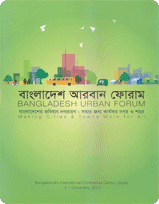
1st Conference of BUF
- Background
- Context
- Themes of the 1st Session of BUF
- Venue
- Messages
- Programme Details (5-7 December, 2011): At a Glance
- Inaugural Session
- Urban Exhibition
- Programme Sessions - Day 1
- Programme Sessions - Day 2
- Programme Sessions - Day 3
- Declaration
- Closing Session
- Feedback of the Participants
- Participation in the First Sessions of the BUF
- Organizers and Partners
- Organizing Committee
- Sub-committee(s)
- Read news of BUF in National Dailies
- Photo Gallery
Context
Bangladesh is urbanizing rapidly. The annual population growth rate of approximately 4 per cent in urban areas is more than 2.5 times that in rural areas. The majority of the urban population in Bangladesh is concentrated in a few large cities. Dhaka – with 13 million people – accounts for about 40 per cent of the total urban population (UN-HABITAT, State of the World’s Cities 2008-2009). It is predicted that by 2030 about 80 million people will be living in Bangladesh’s towns and cities.
All city dwellers feel the consequences of this boom, but it is the poorest that are affected most; mulnerable to poor health and other risks and with often limited access to public services. The Bangladesh Bureau of Statistics reports that 21 per cent of the urban population is below the poverty line, a third of whom are extreme poor.
A number of national accessments have identified this issue as critical for the development of Bangladesh. The 2009 MDGs Progress Report, jointly prepared with the Government and the UN System in Bangladesh, includes specific references to the centrality of urban policies to poverty reduction. Importantly, stakeholders agree that the challenges arising from rapid urbanization can be met, and indeed, can be leveraged for positive impacts.
Urbanization is a driver of economic growth and, managed well, will bring benefits not just to the poor in urban areas, but to the nation more broadly. Effective and positive urbanization requires a comprehensive understanding, the tackling of misconceptions, new partnerships, new policies and new approaches.
BUF Organizers



